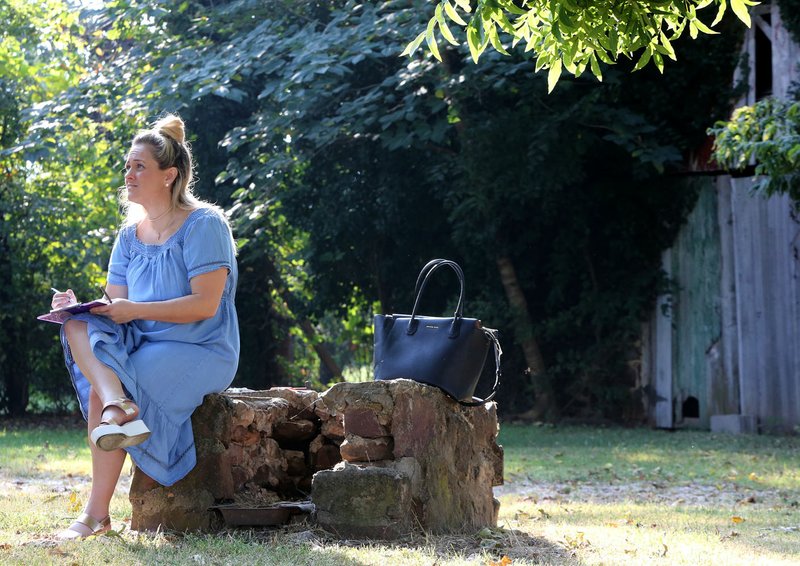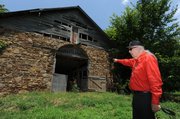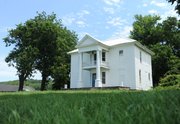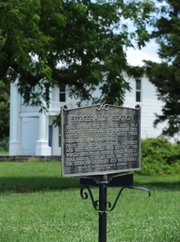We kept traveling all day and night ... our way during Friday afternoon and evening being through an extremely dusty, hilly and stony road ... This brought us to Callahan's, but twelve miles from Fayetteville ... We greased our wagon, changed horses and got some breakfast -- all in an incredibly short space of time -- after which, we set out for Fayetteville.
-- Waterman L. Ormsby, Reporter, New York Herald
The only through passenger on the first westbound stagecoach
of the Butterfield Overland Mail Co.
Fitzgerald’s Station
Through the Years
One of the earliest homesteads in all of Northwest Arkansas — early 1830s
Well-known inn and tavern on old military road/wire road — by late 1830s
Witness to two Cherokee detachments on the Trail of Tears — 1837, 1839
Station on Butterfield Overland stagecoach route — 1858 to 1860
Civil War soldiers passed, and two skirimishes broke out nearby — 1863 to 1864
Stable listed as one of “Arkansas’ Most Endangered Places” by the Historic Preservation Alliance of Arkansas — 2000
Listed on National Register of Historic Places (one only two nonresidential structures from before 1875 in the state) — 2003
Earned designation from National Park Service as certified site on Trail of Tears National Historic Trail — 2008
Called “most intact farmstead of the era not on a museum site,” by Gary Clements, an Arkansas architect — 2018
SOURCE: Shiloh Museum of Ozark History
Butterfield Coach Road, Butterfield Elementary School, Butterfield Trail Village.
Many people in Northwest Arkansas might not know it, but they are surrounded by history. The stagecoach, an iconic, romantic symbol of the Old West, traveled right through Northwest Arkansas. Stops were made at Elkhorn Tavern at Pea Ridge, in Rogers, Springdale and Fayetteville before heading south to Fort Smith and west to San Francisco.
Several local groups are working to preserve part of that history. A stone barn from the time still stands in Springdale. It was built by crews working for John Butterfield, who from 1858 to 1861 ran the Butterfield Overland Mail stagecoach operation, carrying mail and passengers from the Mississippi River to California. The 1857 barn is one of the few original structures left from the 2,812-mile route, according to Allyn Lord, director of the Shiloh Museum of Ozark History in Springdale.
An 1870s Greek Revival house also stands on the site, replacing the home built by the first settler, John Fitzgerald. The family operated an inn and tavern at that location as early as the 1830s. The current structure likely was built on the footprint of that inn and tavern, Lord said, relating research done by the Arkansas Archeological Survey in 2004.
The barn, surrounding structures (including two houses built as late as the 1960s) and land were purchased late last year by the NWA Trailblazers, a nonprofit organization that builds trails in Northwest Arkansas. The group plans to finish this summer 10 miles of trails on Fitzgerald Mountain in eastern Springdale, which will include a trailhead and parking area next to the historic house.
The Trailblazers organization intends to deed the property to the city of Springdale this summer, said Erin Rushing, executive director.
"We bought it because, one, it was a historic property listed for sale. Also, it was an opportunity for preservation, and we needed a trail head," he said simply.
HOMESTEAD
John Fitzgerald and wife Mary settled east of Springdale around 1830, forging one of the earliest homesteads in Northwest Arkansas, Lord shared. The major crop of these farmers and slave holders was apples, with orchards surrounding the property.
The family established the respite for travelers because the home stood next to the "Military Road" from Springfield, Mo., to Fort Smith. The dirt road likely started as an Indian path,
The family witnessed two detachments of the Cherokee Indians travel past the house along the Trail of Tears. The B.B. Cannon detachment arrived at Fitzgerald's on Dec. 25, 1837, and the Richard Taylor detachment passed the house on March 10, 1839.
Nearly 30 years later, Civil War soldiers from both sides marched the road as they advanced and retreated, and two skirmishes took place nearby. When the telegraph came to Northwest Arkansas in 1860, wires were strung along the road's byways.
The Fitzgerald family sold the farm in 1872.
Later landowners added vineyards and beef cattle to the land. The property changed hands several times in the 1900s and remained a working farm until 1990, Lord concluded.
BUTTERFIELD LINE
But the family and the site were also players in history.
John Butterfield, president of the fledgling American Express Co., in 1857 earned the first government contract to carry mail from St. Louis, Mo., to San Francisco in just two weeks time. He was given only one year to for his stagecoaches to roll.
Butterfield purchased hundreds of wagons, thousands of mules and horses, and even more feed and supplies, and delivered them to various stations along the route, according to the 2008 book, Driver's Guide to the Butterfield Overland Mail Route by Kirby Sanders and the Heritage Trail Partners in Northwest Arkansas
Butterfield crews built barns and wells at the stations -- including the one in Springdale -- and the coach line often followed established roads, as was the case in Northwest Arkansas.
Stages rolled 24 hours a day, with each driver covering 50 to 60 miles, changing each morning and evening. A coach would travel just more than 100 miles a day. At the end of their routes, drivers turned the coach over to a new team and brought the next stage back to their point of origin a few days later, Sanders wrote.
Each station was supplied with a change of drivers and a coach appropriate for the terrain. Sure-footed mules pulled the stages through the rugged Ozark Mountains of southeastern Missouri and northwestern Arkansas.
On Sept. 16, 1858, a single stagecoach left Tipton, Mo., on its first journey to San Francisco. The day before, another coach had left San Francisco carrying mail bound for Missouri and points east.
But the Butterfield Overland Mail service would travel this route for just three years. The Indian raids and confiscation of the "federal property" by troops in Confederate states -- and Confederate sympathizers in Missouri and Arkansas -- led to a northern reroute for the stagecoaches, Sanders said.
In 1869, the railroad from coast to coast was completed, allowing for mail delivery in just days, making stage service obsolete.
NEXT
Now, the city of Springdale works through its museum to consider long-term restoration of the site. The Northwest Arkansas Regional Planning Commission and Heritage Trail Partners also are on board, Lord said.
Gary Clements of Little Rock, an architect who has worked with the city on the restoration of the Shiloh Meeting Hall on museum property and the possible restoration of Rabbit Foot Lodge in J.B. Hunt Park, visited the site late last year and shared an informal game plan, Lord said.
Clements suggested four phases of restoration:
• An assessment to determine what structures are a risk, with a guide to anticipated costs. The site also includes a pump house, a chicken house, an outdoor fire pit, a cistern, stone entry markers, two modern houses and newer sheds and barns.
• Stabilization to prevent further damage or loss, which could include shoring porches, stabilizing walls and new roofs for the structures.
• Security to restrict access and prevent damage.
• Site master planning to determine future use.
The City Council members will make the ultimate decision on the site's future, Lord said.
"Do we want to preserve it? Do we want to interpret it?" she asked. "Many people have called the city and museum with interest and ideas."
To complete the first step, the assessment, Clements will charge the city $29,153. A grant from the Arkansas Historic Preservation Program covers two-thirds of the cost. The Springdale City Council authorized last week the spending of $9,718 to take care of the city's part.
At some point, the cost of preservation might be steeper than the mountain behind the former stagecoach station, Lord admitted.
"But what's history worth?" asked Springdale City Council member Mike Overton. "It's one of the few historic sites in Springdale. It's our obligation to preserve history whenever we can. People need to know about our city."
"It likely will sit for a while," Lord said of the property. "But that's great, it gives us more thoughtful time to consider what to do with it."
NAN Our Town on 03/22/2018



